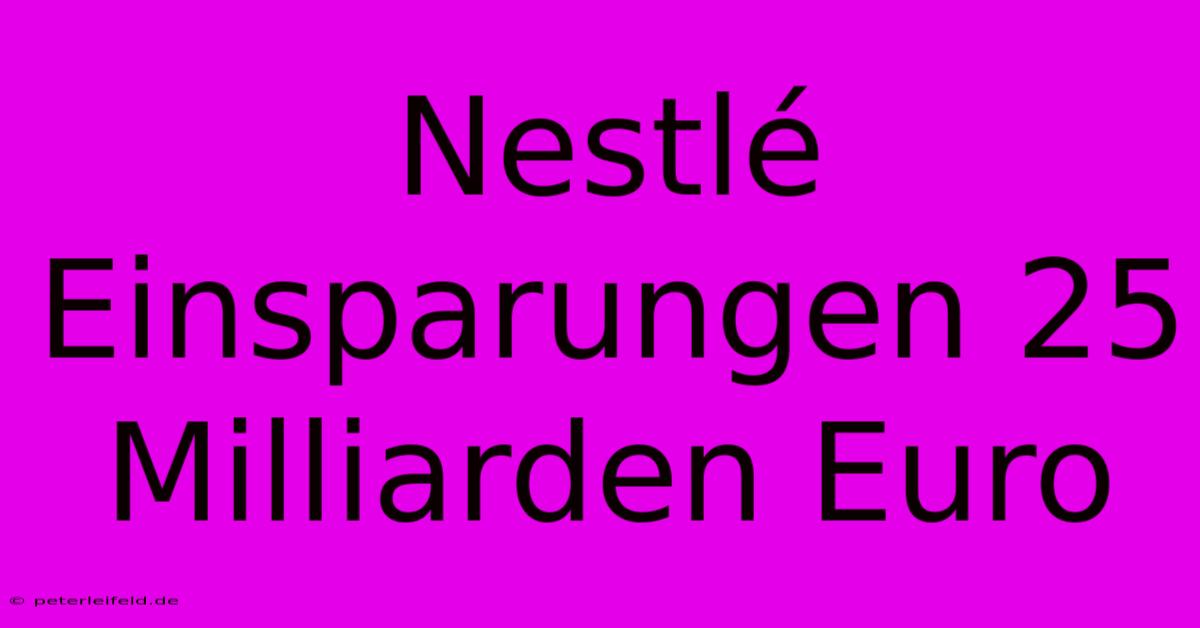Nestlé Einsparungen 25 Milliarden Euro

Discover more detailed and exciting information on our website. Click the link below to start your adventure: Visit Best Website Nestlé Einsparungen 25 Milliarden Euro. Don't miss out!
Table of Contents
Nestlé's €25 Billion Savings: A Deep Dive into Cost-Cutting Success (and What it Means for You)
Nestlé, that mega-corp behind everything from KitKats to Nescafé, recently announced a whopping €25 billion in savings. Seriously, that's a ton of money. But how did they do it, and what does this massive cost-cutting mean for consumers like us? Let's unpack it.
The €25 Billion Question: How Did Nestlé Do It?
Nestlé's cost-cutting wasn't some magic trick. It was a strategic overhaul, a multi-pronged attack on expenses. Think of it like decluttering your entire house – except this house is a global food empire.
First off, efficiency improvements were key. That means streamlining their supply chain, optimizing their manufacturing processes, and generally making things run smoother. Imagine fewer trucks on the road, less waste in the factory – all adding up to big savings. It's like they finally got rid of all that extra junk in the pantry.
Secondly, digitalization played a huge role. This isn't just about fancy new apps; it's about using data to make better decisions. From predicting demand to optimizing logistics, technology helped them slash costs. They probably even used some AI to figure out the most efficient way to stack those KitKat boxes.
Finally, they focused on restructuring. This unfortunately often means job losses in some areas. But this tough decision allowed them to focus resources on more profitable areas and cut unnecessary overhead. It's never easy, but sometimes a little "spring cleaning" is needed.
What Does This Mean for Consumers? (Spoiler Alert: It's Complicated)
So, Nestlé saved €25 billion. Yay, right? Well, maybe. While some might hope this translates to lower prices on our favorite treats, the reality is more nuanced.
Some of these savings could be passed on to consumers in the form of lower prices. But Nestlé's also got shareholders to please, and they're likely expecting a hefty return on their investment. This means some of the savings could go straight to boosting profits.
It's a tricky balance. We as consumers have to hope (and maybe demand) that some of that €25 billion translates into better value for our money. Maybe cheaper coffee? Or perhaps more sustainable sourcing? We can only hope they'll use some of those savings to make their products and business practices more environmentally friendly.
The Future of Nestlé and its Cost-Cutting Strategies
Nestlé's cost-cutting success is a case study in corporate efficiency. Their strategy shows the power of combining operational improvements, technological advancements, and strategic restructuring. But, let's be real, this is a big corporation, and we're still waiting to see the full effect of these savings on prices and the overall customer experience. The real test will be how they choose to spend those billions in the years to come.
Ultimately, the success of Nestlé's cost-cutting strategy will be determined by how it impacts not only their bottom line, but also its relationship with consumers and the long-term sustainability of its operations. It's a story that's still unfolding, folks, and we'll be watching closely. Stay tuned.

Thank you for visiting our website wich cover about Nestlé Einsparungen 25 Milliarden Euro. We hope the information provided has been useful to you. Feel free to contact us if you have any questions or need further assistance. See you next time and dont miss to bookmark.
Featured Posts
-
Lufthansa Aktie Qube Research Stoppt Angriff
Nov 19, 2024
-
Vergewaltigungsverdacht Sohn Mette Marit
Nov 19, 2024
-
Mazan Vergewaltigungsprozess Urteil
Nov 19, 2024
-
Val Thorens Kabinenunfall Mit Verletzten
Nov 19, 2024
-
Game Awards 2024 Nominierte Uebersicht Astro Bot
Nov 19, 2024
